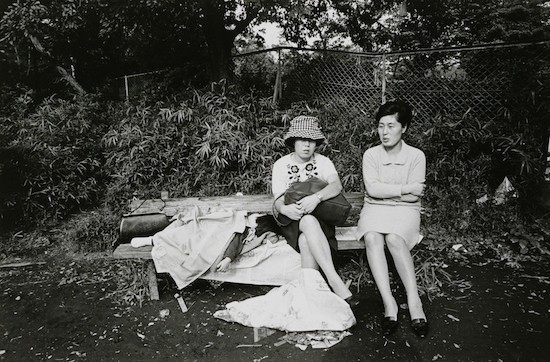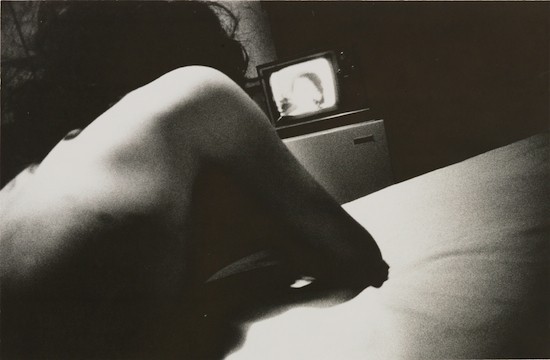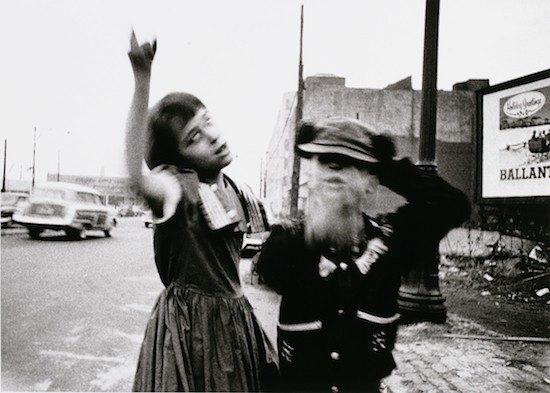Provoke and Con-pora: In the blank space of ‘1968 – Japanese Photography’ (Tokyo Metropolitan Museum of Photography) I
 Shigeo Gocho, from the series “Hibi – Day to Day” (1967-70)
Shigeo Gocho, from the series “Hibi – Day to Day” (1967-70)Settling the question of whether theories on Con-pora are correct hangs on how they differentiate Con-Pora from Provoke. These two approaches to photographic practice, both appearing during the same period, have tended to be confused with one another from the very start. While there is no shortage of discussion of the things they have in common (the wide lens, the horizontal positioning, the everyday snapshots), their differences are often limited to “only the finish of the film or print” (see below, Shomei Tomatsu). In other words, the difference in effects [Con-pora = tidy photographs, Provoke = arebure (out-of-focus and blurred) photographs], or alternatively, the difference in their approach to the production of photographs, [the former affirming reality (non-political) and the latter being critical of reality (political)], and in the end, the obscure differences that vary according to the viewer. Any criticism that properly demarcates one from the other is all but non-existent.
But Provoke members Daido Moriyama and Takuma Nakahira have quite clearly refused to have Provoke be confused with Con-pora.
Moriyama: […] Dispensing with the conscious reworkings that describe trivial things, for example, going somewhere and taking photos is nothing other than a loss of artistic subjectivity. In the styles that are collectively referred to as Con-pora can be seen the evil prosperity of a peaceful Japan.
Nakahira: Yes, there is an evil prosperity. Didn’t you receive the Hibi – Day to Day photo collection? If you look at it, you ‘ll wonder how people can live in such an apathetic and nonchalant way. […] You’re better off not taking photographs at all if there’s no resentment, no bitterness. I don’t want to use words like malice or pathos but unless there is some kind of ill feeling, there is neither “a date” nor anything else. It’s the life of an earthworm. I don’t want anything to do with the life of an earthworm. I sort of resent being lumped together with those kinds of photos. […] Their feature is burning the edges of the photographic paper black. The stability provided by that effect reflects nothing but a weak line of sight. (1)
Masao Sekiguchi and Shigeo Gocho’s Hibi – Day to Day is apparently the day to day of an earthworm. Theirs is a vehement negation based on the fact that the differences between Con-pora and Provoke are in general vague, but if this is the case, we could also ask why are the two confused with each other? And if, for Provoke, Con-pora is inexcusable, then where do their differences lie?
 Daido Moriyama – Untitled from Provoke No. 2 (1969)
Daido Moriyama – Untitled from Provoke No. 2 (1969)Let’s take a look at another well-known document. Prior to this interview with Nakahira and Moriyama, Shomei Tomatsu, in the January 1972 edition of Camera Mainichi, published the words “Wake up! Patients of Are-bure, Con-pora.” As he criticizes the members of both Are-bure and Con-pora by likening them to “patients,” Tomatsu is attempting to set them apart.
The symptoms of Are-bure and Con-pora are very similar in appearance but it must be said are crucially different in reality. […] In short, the difference in how the camera-wielding patients involve themselves with the status quo can as a result be regarded as the bipolar disintegration of Con-pora and Are-bure. “Status quo” […] that is the whole of the time and space in which the patient is living, not limited to the object being photographed, expanding before the eyes of the patient, at the same time as signifying a system, it also includes the patient who is himself training his camera on the system. The Con-pora member’s awareness of the status quo is positive and that of the Are-bure patient could be said to be negative (page 61).
The difference between Provoke and Con-pora is reduced to the difference in attitude towards the reality in front of one’s eyes. Tomatsu is criticizing both of them for their attitude. So what kind of criticism is it?
The so-called “realism” discourse – photography is a medium that records the stark reality of the world in naked form – which led to modern photography, emerged more or less in the 1910s, was established between the 1920s to 1930s in an environment of surrealism and documentary, and began to wane from the late 1960s through the 1970s. While based on discourse of the same type, the history of modern photography which has changed in many ways – Stieglitz, Weston, Evans, Renger-Patzsch, Cartier-Bresson, Klein, Frank and so on – is nothing other than a history of whether a photograph of what kind of style and taken using what kind of method can convey to the viewer “the real world as it is.”
 William Klein – Dance in Brooklyn, New York (1955), collection Tokyo Metropolitan Museum of Photography.
William Klein – Dance in Brooklyn, New York (1955), collection Tokyo Metropolitan Museum of Photography.For example, Klein’s “are-bure” was introduced to represent New York as dynamic and fluid, not possible with conventional, static “straight photography.” This method of Klein’s is known to have influenced the Provoke generation of Japanese photographers. Are-bure, however, which was introduced as a positive way to expose the real New York, was being put into practice as a negative method in Japan. That is because the “naked reality” in which Klein of the 1950s still believed could not be believed in any more by photographers in Japan in the late 1960s. Let’s listen to the skepticism of Takuma Nakahira and Koji Taki.
[…] It means that the fact that photographs belong to a highly semantic world cannot be avoided. While they are trying to break this by means of a direct vision, they take on meaning again. Consequently it is doubtful as to what extent believing naively in such things as the naked eye or the immediacy of the physical body is possible while living in this city. (2)
We live surrounded by images. It could be said that, instead of fulfilling their original function as symbols for indicating reality, they have formed a second kind of reality that could be called pseudo-reality. Instead of reality, they are constantly forcing on us a fictional angle of view that is masquerading as reality. (3)
Therefore, “naked reality” always has to manifest itself, not as naïve realism, but rather, negatively at the limit of criticism. The Provoke members do not directly identify “naked reality.” The only reason that “naked reality” has come to be represented directly through the are-bure that is the “scars” remaining on the image is that they were conscious of the fact that such directness resulted in their getting closer to the lie, to the advertisement in an unlimited way. The photographs dressed in “as it is” or “real,” are the “false photographs” about which Nobuyoshi Araki declared, in the preamble to Sentimental Journey (1971), that he “cannot stand them any more.” For the members of Provoke, are-bure means gradually getting closer to “naked reality” and also a technique to defer that to infinity and beyond without it being polluted by a lie. However, put another way, in contrast to the fact that Klein’s are-bure was a methodology (how) that has as its premise a real object (“what” = New York), the Provoke equivalent of this was nothing other than a self-movement of “how” that lacked a “what.” It became in the end a mannerism, the kind that is appropriated even in commercials for the national railway. (To be continued)
All photos courtesy Tokyo Metropolitan Museum of Photography
“1968 – Japanese Photography” was held form May 11 through June 15, 2013 at the Tokyo Metropolitan Museum of Photography.
-
From a conversation between Daido Moriyama and Takuma Nakahira held August 2, 1972 at the Yamanoue Hotel published in Shashin yo Sayonara (Farewell Photography) by Daido Moriyama (Shashin Hyoronsha, 1972) p. 302.
- Koji Taki, “Kiba no nai wakamonotachi” (Youth without fangs), SD, June 1971, p. 118.
- Takuma Nakahira “Why an Illustrated Botanical Dictionary” in Nakahira Takuma no shashinron (Takuma Nakahira’s theory of photography), (Richiesta, 2001), pp. 11-12.
